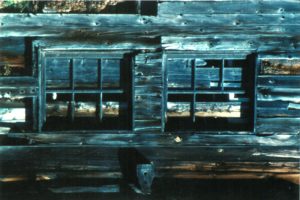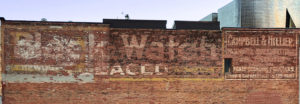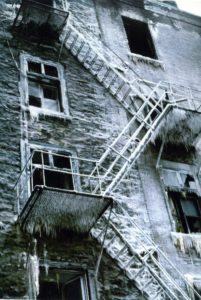‘…and to dust you shall return.’ Genesis 3:19
As a photographer, I always assumed my interests were odd. My preferred subjects were dilapidated buildings, rusted metals and abandoned spaces. I love detailed close ups of ghost phrases — slogans and ads painted on crumbling surfaces that are still just visible to the eye, decades after the products were available. Driving through the countryside I will often pull over to photograph a collapsed shed, a rusted sign, or a crumbling wall.
Given how strange I assumed my interests to be, imagine how surprised I was to be invited to put together an exhibition of my works for a gallery in Australia. And when a book was commissioned bringing these photographic images together — Border Crossings: Words & Images — I began to think that perhaps my interests weren’t so odd after all. This was later confirmed when I discovered that hundreds of tours were actually hosted in many cities across North America taking sightseers around to dilapidated buildings to photograph famous ghost images advertising everything from baked goods to window cleaning services.
Of course, with the proliferation of the internet, it is now easy to see that this interest is indeed widely shared. Pinterest alone is a treasure trove. There are so many fine artists who choose crumbling structures as the inspiration for their art, that instead we should wonder why this view is so popular. Perhaps, in part, it’s because there is something organic about seeing a wooden barn blending back into the soil, its timbers returning to the earth. There is something strangely reassuring and natural about this cycle of life. It can also be viewed another way, such that decay speaks to our own mortality — a metaphor of where we are all heading in the not too distant future.
It wasn’t until I saw a beautiful photograph of an abandoned church in a ghost town in the US, however, that I started to connect the idea of these photos to a question of faith and loss. It occurred to me that perhaps the effect of transforming the demise of a structure into beautiful art is something of a metaphor for the power of faith to similarly help us recover from, and even accept, loss. I realize now that many of the photographs I took for that exhibition were shot in the wake of my father’s passing, and many of the frames that I built for the images of dilapidated buildings were made from timbers from my father’s shop. Strange how it can take a lifetime to put two and two together.
Pope Francis has spoken often of the need to mourn, and the natural sadness that comes when we lose a loved one, but he reminds us always of the greater joy behind this loss — that death is a beginning, not an end. In the harsh moment of tragedy this can be difficult to believe. Our hearts are broken and the loss weighs heavily. But over time we come to see the gift of the one we’ve lost, and to see that their light continues to shine. And knowing that they have returned to life, and have experienced the ultimate encounter with our Lord, is something to celebrate. In a way, our loved ones are ghost phrases, etched on our lives, faded, but never lost. As Pope Francis has put it, ‘Our loved ones have not disappeared into dark nothingness: Hope assures us that they are in God’s good and strong hands. Love is stronger than death.’
Perhaps this is the attraction that such buildings have always held for me. They are a living testimonial to what we build, in earnest and good heart, here on planet earth, but a reminder too that there’s a greater plan in place for all of us. The phrase ‘ashes to ashes’ may not actually appear in the Bible, but the passage that gave rise to it speaks beautifully of this fact: ‘By the sweat of your face you shall eat bread until you return to the ground, for out of it you were taken; you are dust, and to dust you shall return’ (Genesis 3:19). The more famous wording comes from the 1662 version of the Book of Common Prayer, in the description of what an appropriate burial service should say: ‘We therefore commit this body to the ground; earth to earth, ashes to ashes, dust to dust.’
In the end — there’s that phrase again — we are all just ghost phrases upon the landscape. And it is the measure of our good deeds, our influence or heart, that determines how the image of our time on this good earth will fade, or how fondly others gaze upon it, refusing to let it go entirely.










